CHAPTER 5 Solving First Degree Equations in One Variable
5.1 Solve Equations Using the Subtraction and Addition Properties of Equality
Learning Objectives
By the end of this section, you will be able to:
- Solve equations using the Subtraction and Addition Properties of Equality
- Solve equations that need to be simplified
- Translate an equation and solve
- Translate and solve applications
We are now ready to “get to the good stuff.” You have the basics down and are ready to begin one of the most important topics in algebra: solving equations. The applications are limitless and extend to all careers and fields. Also, the skills and techniques you learn here will help improve your critical thinking and problem-solving skills. This is a great benefit of studying mathematics and will be useful in your life in ways you may not see right now.
Solve Equations Using the Subtraction and Addition Properties of Equality
Solving an equation is like discovering the answer to a puzzle. The purpose in solving an equation is to find the value or values of the variable that make each side of the equation the same. Any value of the variable that makes the equation true is called a solution to the equation. It is the answer to the puzzle.
Solution of an Equation
A solution of an equation is a value of a variable that makes a true statement when substituted into the equation.
The steps to determine if a value is a solution to an equation are listed here.
HOW TO: Determine whether a number is a solution to an equation.
- Substitute the number for the variable in the equation.
- Simplify the expressions on both sides of the equation.
- Determine whether the resulting equation is true.
- If it is true, the number is a solution.
- If it is not true, the number is not a solution.
EXAMPLE 1
Determine whether ![]() is a solution for
is a solution for ![]() .
.
Solution
 |
|
 |
 |
| Multiply. |  |
| Add. |  |
Since ![]() results in a true equation,
results in a true equation, ![]() is a solution to the equation
is a solution to the equation ![]() .
.
TRY IT 1.1
Is ![]() a solution for
a solution for ![]()
Show answer
no
TRY IT 1.2
Is ![]() a solution for
a solution for ![]()
Show answer
no
In that section,we will model how the Subtraction and Addition Properties work and then we will apply them to solve equations.
Subtraction Property of Equality
For all real numbers ![]() , and
, and ![]() , if
, if ![]() , then
, then ![]() .
.
Addition Property of Equality
For all real numbers ![]() , and
, and ![]() , if
, if ![]() , then
, then ![]() .
.
When you add or subtract the same quantity from both sides of an equation, you still have equality.
We will introduce the Subtraction Property of Equality by modeling equations with envelopes and counters. (Figure .1) models the equation ![]() .
.
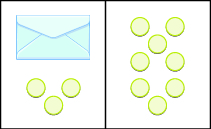
The goal is to isolate the variable on one side of the equation. So we ‘took away’ ![]() from both sides of the equation and found the solution
from both sides of the equation and found the solution ![]() .
.
Some people picture a balance scale, as in (Figure .2), when they solve equations.
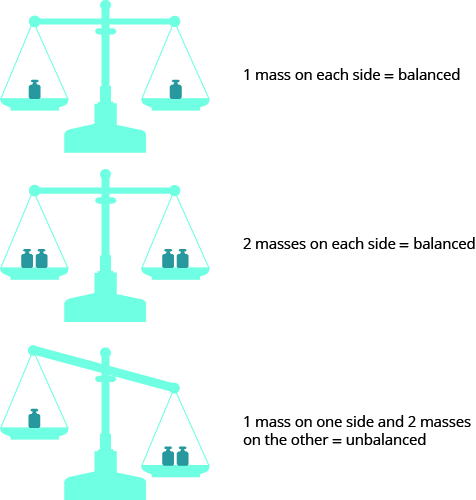
The quantities on both sides of the equal sign in an equation are equal, or balanced. Just as with the balance scale, whatever you do to one side of the equation you must also do to the other to keep it balanced.
Let’s see how to use Subtraction and Addition Properties of Equality to solve equations. We need to isolate the variable on one side of the equation. And we check our solutions by substituting the value into the equation to make sure we have a true statement.
EXAMPLE 2
Solve: ![]() .
.
Solution
To isolate ![]() , we undo the addition of
, we undo the addition of ![]() by using the Subtraction Property of Equality.
by using the Subtraction Property of Equality.
 |
||
| Subtract 11 from each side to “undo” the addition. |  |
|
| Simplify. |  |
|
| Check: |  |
|
| Substitute |
 |
|
 |
||
Since ![]() makes
makes ![]() a true statement, we know that it is a solution to the equation.
a true statement, we know that it is a solution to the equation.
TRY IT 2.1
Solve: ![]() .
.
Show answer
x = −16
TRY IT 2.2
Solve: ![]() .
.
Show answer
x = −20
In the original equation in the previous example, ![]() was added to the
was added to the ![]() , so we subtracted
, so we subtracted ![]() to ‘undo’ the addition. In the next example, we will need to ‘undo’ subtraction by using the Addition Property of Equality.
to ‘undo’ the addition. In the next example, we will need to ‘undo’ subtraction by using the Addition Property of Equality.
EXAMPLE 3
Solve: ![]() .
.
Solution
 |
||
| Add 4 to each side to “undo” the subtraction. |  |
|
| Simplify. |  |
|
| Check: |  |
|
| Substitute |
 |
|
 |
||
| The solution to |
||
TRY IT 3.1
Solve: ![]() .
.
Show answer
−1
TRY IT 3.2
Solve: ![]() .
.
Show answer
−4
Now let’s solve equations with fractions.
EXAMPLE 4
Solve: ![]() .
.
Solution
 |
||
| Use the Addition Property of Equality. |  |
|
| Find the LCD to add the fractions on the right. |  |
|
| Simplify |  |
|
| Check: |  |
|
 |
 |
|
| Subtract. |  |
|
| Simplify. |  |
|
| The solution checks. | ||
TRY IT 4.1
Solve: ![]() .
.
Show answer
![]()
TRY IT 4.2
Solve: ![]() .
.
Show answer
![]()
Let’s solve equations that contained decimals.
EXAMPLE 5
Solve ![]() .
.
Solution
 |
||
| Use the Addition Property of Equality. |  |
|
| Add. |  |
|
| Check: |  |
|
| Substitute |
 |
|
| Simplify. |  |
|
| The solution checks. | ||
TRY IT 5.1
Solve: ![]() .
.
Show answer
b = 6.4
TRY IT 5.2
Solve: ![]() .
.
Show answer
c = 14
Solve Equations That Need to Be Simplified
In the examples up to this point, we have been able to isolate the variable with just one operation. Many of the equations we encounter in algebra will take more steps to solve. Usually, we will need to simplify one or both sides of an equation before using the Subtraction or Addition Properties of Equality. You should always simplify as much as possible before trying to isolate the variable.
EXAMPLE 6
Solve: ![]() .
.
Solution
The left side of the equation has an expression that we should simplify before trying to isolate the variable.
 |
|
| Rearrange the terms, using the Commutative Property of Addition. |  |
| Combine like terms. |  |
| Add 11 to both sides to isolate |
 |
| Simplify. |  |
| Check. Substitute 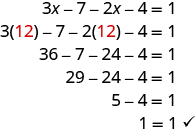 |
The solution checks.
TRY IT 6.1
Solve: ![]() .
.
Show answer
y = 15
TRY IT 6.2
Solve: ![]() .
.
Show answer
z = 2
EXAMPLE 7
Solve: ![]() .
.
Solution
The left side of the equation has an expression that we should simplify.
 |
|
| Distribute on the left. |  |
| Use the Commutative Property to rearrange terms. |  |
| Combine like terms. |  |
| Isolate n using the Addition Property of Equality. |  |
| Simplify. |  |
| Check. Substitute 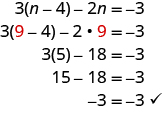 The solution checks. |
TRY IT 7.1
Solve: ![]() .
.
Show answer
p = 5
TRY IT 7.2
Solve: ![]() .
.
Show answer
q = −16
EXAMPLE 8
Solve: ![]() .
.
Solution
Both sides of the equation have expressions that we should simplify before we isolate the variable.
 |
|
| Distribute on the left, subtract on the right. |  |
| Use the Commutative Property of Addition. |  |
| Combine like terms. |  |
| Undo subtraction by using the Addition Property of Equality. |  |
| Simplify. |  |
| Check. Let |
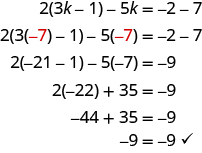 |
| The solution checks. |
TRY IT 8.1
Solve: ![]() .
.
Show answer
h = −1
TRY IT 8.2
Solve: ![]() .
.
Show answer
x = 1
Translate an Equation and Solve
Previously, we translated word sentences into equations. The first step is to look for the word (or words) that translate(s) to the equal sign. The list below reminds us of some of the words that translate to the equal sign (=):
- is
- is equal to
- is the same as
- the result is
- gives
- was
- will be
Let’s review the steps we used to translate a sentence into an equation.
HOW TO: Translate a word sentence to an algebraic equation.
- Locate the “equals” word(s). Translate to an equal sign.
- Translate the words to the left of the “equals” word(s) into an algebraic expression.
- Translate the words to the right of the “equals” word(s) into an algebraic expression.
Now we are ready to try an example.
EXAMPLE 9
Translate and solve: five more than ![]() is equal to
is equal to ![]() .
.
Solution
| Translate. |  |
| Subtract 5 from both sides. |  |
| Simplify. |  |
| Check: Is |
  The solution checks. |
TRY IT 9.1
Translate and solve: Eleven more than ![]() is equal to
is equal to ![]() .
.
Show answer
x + 11 = 41; x = 30
TRY IT 9.2
Translate and solve: Twelve less than ![]() is equal to
is equal to ![]() .
.
Show answer
y − 12 = 51; y = 63
EXAMPLE 10
Translate and solve: The difference of ![]() and
and ![]() is
is ![]() .
.
Solution
| Translate. |  |
| Simplify. |  |
| Check. |
    |
| The solution checks. |
TRY IT 10.1
Translate and solve: The difference of ![]() and
and ![]() is
is ![]() .
.
Show answer
4x − 3x = 14; x = 14
TRY IT 10.2
Translate and solve: The difference of ![]() and
and ![]() is
is ![]() .
.
Show answer
7a − 6a = −8; a = −8
Translate and Solve Applications
In most of the application problems we solved earlier, we were able to find the quantity we were looking for by simplifying an algebraic expression. Now we will be using equations to solve application problems. We’ll start by restating the problem in just one sentence, assign a variable, and then translate the sentence into an equation to solve. When assigning a variable, choose a letter that reminds you of what you are looking for.
EXAMPLE 11
The Robles family has two dogs, Buster and Chandler. Together, they weigh ![]() pounds.
pounds.
Chandler weighs ![]() pounds. How much does Buster weigh?
pounds. How much does Buster weigh?
Solution
| Read the problem carefully. | |
| Identify what you are asked to find, and choose a variable to represent it. | How much does Buster weigh? Let |
| Write a sentence that gives the information to find it. | Buster’s weight plus Chandler’s weight equals 71 pounds. |
| We will restate the problem, and then include the given information. | Buster’s weight plus 28 equals 71. |
| Translate the sentence into an equation, using the variable |
 |
| Solve the equation using good algebraic techniques. |   |
| Check the answer in the problem and make sure it makes sense. | Is 43 pounds a reasonable weight for a dog? Yes. Does Buster’s weight plus Chandler’s weight equal 71 pounds? |
| Write a complete sentence that answers the question, “How much does Buster weigh?” | Buster weighs 43 pounds |
TRY IT 11.1
Translate into an algebraic equation and solve: The Pappas family has two cats, Zeus and Athena. Together, they weigh ![]() pounds. Zeus weighs
pounds. Zeus weighs ![]() pounds. How much does Athena weigh?
pounds. How much does Athena weigh?
Show answer
a + 6 = 13; Athena weighs 7 pounds.
TRY IT 11.2
Translate into an algebraic equation and solve: Sam and Henry are roommates. Together, they have ![]() books. Sam has
books. Sam has ![]() books. How many books does Henry have?
books. How many books does Henry have?
Show answer
26 + h = 68; Henry has 42 books.
Devise a Problem-Solving Strategy
- Read the problem. Make sure you understand all the words and ideas.
- Identify what you are looking for.
- Name what you are looking for. Choose a variable to represent that quantity.
- Translate into an equation. It may be helpful to restate the problem in one sentence with all the important information. Then, translate the English sentence into an algebra equation.
- Solve the equation using good algebra techniques.
- Check the answer in the problem and make sure it makes sense.
- Answer the question with a complete sentence.
EXAMPLE 12
Shayla paid ![]() for her new car. This was
for her new car. This was ![]() less than the sticker price. What was the sticker price of the car?
less than the sticker price. What was the sticker price of the car?
Solution
| What are you asked to find? | “What was the sticker price of the car?” |
| Assign a variable. | Let |
| Write a sentence that gives the information to find it. | $24,575 is $875 less than the sticker price $24,575 is $875 less than |
| Translate into an equation. |  |
| Solve. |   |
| Check: | Is $875 less than $25,450 equal to $24,575?
|
| Write a sentence that answers the question. | The sticker price was $25,450. |
TRY IT 12.1
Translate into an algebraic equation and solve: Eddie paid ![]() for his new car. This was
for his new car. This was ![]() less than the sticker price. What was the sticker price of the car?
less than the sticker price. What was the sticker price of the car?
Show answer
19,875 = s − 1025; the sticker price is $20,900.
TRY IT 12.2
Translate into an algebraic equation and solve: The admission price for the movies during the day is ![]() . This is
. This is ![]() less than the price at night. How much does the movie cost at night?
less than the price at night. How much does the movie cost at night?
Show answer
7.75 = n − 3.25; the price at night is $11.00.
Key Concepts
- Determine whether a number is a solution to an equation.
- Substitute the number for the variable in the equation.
- Simplify the expressions on both sides of the equation.
- Determine whether the resulting equation is true.
If it is true, the number is a solution.
If it is not true, the number is not a solution. - Subtraction and Addition Properties of Equality
- Subtraction Property of Equality
For all real numbers a, b, and c,
if a = b then .
. - Addition Property of Equality
For all real numbers a, b, and c,
if a = b then .
.
- Subtraction Property of Equality
- Translate a word sentence to an algebraic equation.
- Locate the “equals” word(s). Translate to an equal sign.
- Translate the words to the left of the “equals” word(s) into an algebraic expression.
- Translate the words to the right of the “equals” word(s) into an algebraic expression.
- Problem-solving strategy
- Read the problem. Make sure you understand all the words and ideas.
- Identify what you are looking for.
- Name what you are looking for. Choose a variable to represent that quantity.
- Translate into an equation. It may be helpful to restate the problem in one sentence with all the important information. Then, translate the English sentence into an algebra equation.
- Solve the equation using good algebra techniques.
- Check the answer in the problem and make sure it makes sense.
- Answer the question with a complete sentence.
Glossary
- solution of an equation
- A solution of an equation is a value of a variable that makes a true statement when substituted into the equation.
Practice Makes Perfect
Solve Equations Using the Subtraction and Addition Properties of Equality
In the following exercises, determine whether the given value is a solution to the equation.
| 1. Is |
2. Is |
| 3. Is |
4. Is |
In the following exercises, solve each equation.
| 5. |
6. |
| 7. |
8. |
| 9. |
10. |
| 11. |
12. |
| 13. |
14. |
| 15. |
16. |
| 17. |
18. |
| 19. |
20. |
Solve Equations that Need to be Simplified
In the following exercises, solve each equation.
| 21. |
22. |
| 23. |
24. |
| 25. |
26. |
| 27. |
28. |
| 29. |
30. |
| 31. |
32. |
| 33. |
34. |
| 35. |
36. |
| 37. |
38. |
Translate to an Equation and Solve
In the following exercises, translate to an equation and then solve.
| 39. The sum of |
40.Five more than |
| 41.Three less than |
42. Ten less than |
| 43. Eight more than |
44. The sum of |
| 45. The difference of |
46. The difference of |
| 47. The difference of |
48. The difference of |
| 49. The sum of |
50. The sum of |
Translate and Solve Applications
In the following exercises, translate into an equation and solve.
| 51.Jeff read a total of |
52. Pilar drove from home to school and then to her aunt’s house, a total of |
| 53. Eva’s daughter is |
54. Pablo’s father is |
| 55. For a family birthday dinner, Celeste bought a turkey that weighed |
56. Allie weighs |
| 57. Connor’s temperature was |
58. The nurse reported that Tricia’s daughter had gained |
| 59. Ron’s paycheck this week was |
60. Melissa’s math book cost |
Everyday Math
| 61.Construction Miguel wants to drill a hole for a |
Baking 62. Kelsey needs |
Writing Exercises
| 63. Write a word sentence that translates the equation |
64. Is |
Answers
| 1. yes | 3. no | 5. x = 5 |
| 7. |
9. p = −11.7 | 11. a = 10 |
| 13. |
15. y = 13.8 | 17. x = −27 |
| 19. |
21. 17 | 23. 8 |
| 25. −20 | 27. 2 | 29. −1.7 |
| 31. −2 | 33. −4 | 35. 6 |
| 37. −41 | 39. x + (−5) = 33; x = 38 | 41.y − 3 = −19; y = −16 |
| 43. p + 8 = 52; p = 44 | 45. 5c − 4c = 60; 60 | 47. |
| 49. −9m + 10m = −25; m = −25 | 51. Let p equal the number of pages read in the Psychology book 41 + p = 54. Jeff read pages in his Psychology book. | 53. Let d equal the daughter’s age. d = 12 − 5. Eva’s daughter’s age is 7 years old. |
| 55. 21 pounds | 57. 100.5 degrees | 59. $121.19 |
| 61. |
63. Answers will vary. |
Attributions
This chapter has been adapted from “Solve Equations Using the Subtraction and Addition Properties of Equality” in Prealgebra (OpenStax) by Lynn Marecek, MaryAnne Anthony-Smith, and Andrea Honeycutt Mathis, which is under a CC BY 4.0 Licence. Adapted by Izabela Mazur. See the Copyright page for more information.

